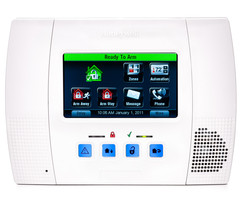Honeywell L5100: Setting the Duress Code
Related Products

Related Categories
Description
This video is about Setting the Duress Code on a Honeywell L5100
Transcript
Hi DIYers! Sterling from Alarm Grid here. Today we're going to show you how to set up your duress code for your LYNX Touch L5100 wireless security system. Your duress code is a special user code, and any Honeywell security system has the duress as a feature. In fact, most security systems have duress as a feature.
The duress code is designed to protect you for a home invasion or a break-in as you're entering the home. So, worst-case scenario, you're coming home from a long day of work, and a guy jumps out from the bushes as you're opening your door. He tells you to disarm your system, no funny stuff. What you do is you enter your duress code, the system disarms, no alarm is tripped, the criminal thinks that he's beat the system and that no one is going to be responding. However, the duress code, while it disarms the system normally, actually sends a special alarm to the central station so that the operator knows, do not call the house, because that would defeat the whole purpose. Instead, send out the police right away. That way, you get your emergency response, and everything is okay.
So obviously, we hope that you never have to use your duress code, but we do hope that you assign it, so if that worst-case scenario happens, you'll be protected. We're going to show you how to set it. What you do is, from the Home Screen you hit more and then tools. Then you're going to want to enter your master code, not your installer code. We have ours set to the default, 1-2-3-4. Now we're in the Master Programming section, and you go into users. The duress, as I said, is a special user code, it's actually assigned to user code slot 16. If you toggle duress, then hit edit, you can see the name is set to duress, and it's programmed to slot 16, which is hard-coded to act as a duress code. Toggle into User Code.
I always recommend that when you're setting a duress code, you set it to something you'll remember during that high-stress situation, where you've got a criminal telling you what to do. Some very common duress codes are 2-5-8-0, right down the middle of the keypad, or 1-3-9-7, around the four corners. You can use any code you would like that's not also a valid user code already programmed, but again, make sure it's something that you'll remember in that situation. So, we're going to set ours to 2-5-8-0, right down the middle. Make sure you click Done, and then, save, and then back out. We have already put our system on test, so that we can demonstrate the duress without actually getting the police out here. What we're going to do is arm the system, and while we wait for this countdown, I'll describe a little bit more about the duress. Again, it's just going to act as a valid disarm. The system will turn off as if we used our normal code. Then that special duress signal, a special type of alarm, is sent to the central station. The operator knows not to call to verify anything. They're just going to simply send out the police.
As soon as our system is fully armed, we're going to simply do the disarm, use the 2-5-8-0 code to show you how the system simply disarms. You know you'll be protected during one of those kinds of break-ins. We have our exit delay set to our 60 seconds, so we have 15 seconds more. Once the system is fully armed, we will show you the disarm. Five more seconds. The system will switch from armed/away, exit now to just straight-up armed/away. So now, we walk into our house, the criminal jumps in behind us, startles us, tells us to disarm. We can click to disarm, and we remember that 2-5-8-0 duress. Ready-to-arm chime, as if we had used the code. The criminal thinks that everything is OK. Meanwhile, the police are on their way.
This is a great security feature to protect your family. We do suggest that you set up a duress code, but make sure that you know the code and that everyone in the house knows not to use that code unless they need to. We want to eliminate false alarms, because there will be no verification calls from the central station, so make sure you're only using the duress in those emergency situations. If you have any questions on using or setting up your duress code, please leave us a comment in the section below. Make sure to subscribe to our channels, so that you'll get updates on all new videos that we post.
- Uploaded
- Duration:
